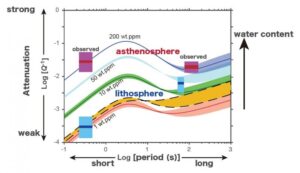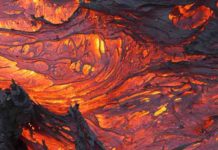
The oceanic lithosphere, which constitutes the top layer including Earth’s crust and mantle below the oceans, has long intrigued scientists due to its peculiar behavior. This layer appears to glide over a weaker region below called the asthenosphere, characterized by high seismic attenuation and low shear wave velocity. The asthenosphere has different physical properties such as lower viscosity than the lithosphere, resulting in a sharp boundary called the lithosphere-asthenosphere boundary (LAB). The exact reasons behind these distinct properties and how they enable the lithosphere to move over the asthenosphere are not clearly understood.
While partial melting occurring near mid-ocean ridges due to high temperatures can produce such anomalous conditions, it fails to account for the sharp and large drops in the velocity of seismic waves observed at the LAB far from mid-ocean ridges. Understanding the origin of this seismic wave velocity drop and attenuation at the oceanic LAB is crucial for deciphering the asthenosphere’s low viscosity and how it facilitates the movement of tectonic plates over the Earth’s surface, giving rise to mountain-building processes, earthquakes, and volcanism.
In this regard, a team of researchers from Japan, led by Professor Takashi Yoshino from the Institute for Planetary Materials at Okayama University, has recently investigated the effect of water on the seismic properties of titanium-free olivine rocks, similar to those found in the asthenosphere. Their study was published in Volume 120, Issue 32 of the journal Proceedings of the National Academy of Sciences on 31 July 2023.
“We experimentally determined the seismic wave attenuation characteristics, parameters for ascertaining the softness of the lithosphere and asthenosphere, under high temperature and pressure using our short-period oscillation generation technology,” explains Prof. Yoshino.
The team studied the anelastic properties of the olivine rocks under conditions which resemble the LAB beneath the old oceanic floor — 3 GPa pressure and temperatures ranging from 1,223 to 1,373 K. They employed in situ X-ray monitoring and subjected the olivine rocks to mechanical testing by generating forced vibrations over a wide range of seismic frequencies — 0.5 to 1,000 seconds — through their unique short-period oscillation technology.
The experiments revealed that water had a significant effect, enhancing the energy dispersion and reducing the elastic moduli of the rocks across a wide range of frequencies. Additionally, the researchers observed a seismic attenuation peak at higher frequencies of 1 to 5 seconds, which became more pronounced with increasing water content. “The presence of water induces attenuation at higher frequencies, leading to a decrease in the velocity of seismic waves. The presence of water also weakens the asthenosphere, which allows the lithosphere to move smoothly over it,” says Prof. Yoshino.
These observations suggest that the oceanic asthenosphere must contain water. This difference in water content between the two layers constituting the LAB can explain the sharp velocity drops as well as the near constant attenuation observed over a wide frequency range in the asthenosphere.
Notably, the researchers acknowledge that their conclusion assumes a negligible effect of iron on hydrogen-related defects in the rocks, indicating the need for further research to explore the anelastic properties of iron-bearing olivine rocks.
Prof. Yoshino highlights the long-term implications of their findings. “The presence of water in the asthenosphere can provide important insights into volcanic and seismic activities, thus facilitating their prediction and detection,” he speculates.
Overall, this study contributes to our understanding of tectonic plate movement, paving the way for better comprehension of various tectonic activities.
Reference:
Chao Liu, Takashi Yoshino, Daisuke Yamazaki, Noriyoshi Tsujino, Hitoshi Gomi, Moe Sakurai, Youyue Zhang, Ran Wang, Longli Guan, Kayan Lau, Yoshinori Tange, Yuji Higo. Effect of water on seismic attenuation of the upper mantle: The origin of the sharp lithosphere–asthenosphere boundary. Proceedings of the National Academy of Sciences, 2023; 120 (32) DOI: 10.1073/pnas.2221770120
Note: The above post is reprinted from materials provided by Okayama University.









